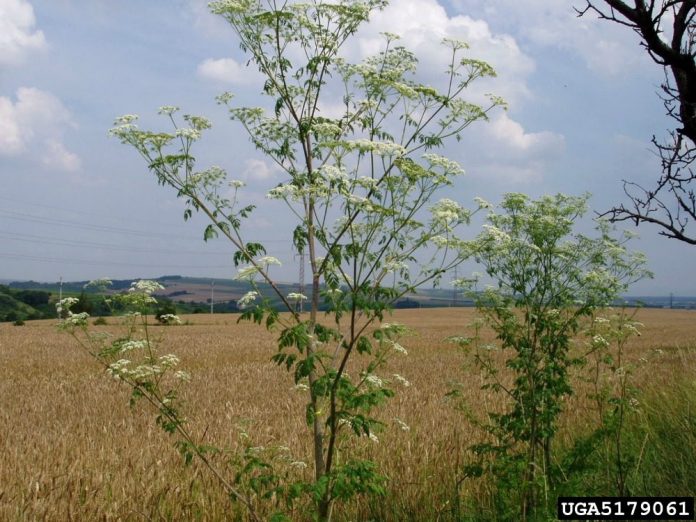
NEWARK, Ohio — Poison hemlock is a weed that livestock owners cannot afford to ignore because all parts of this plant including leaves, stems and roots are poisonous when ingested.
Look for it now
This is a good time to scout both hayfields and pastures for this weed and take steps to control it, says Licking County Extension Educator Ted Wiseman.
The noxious weed looks similar to and smells like other plants in the carrot family (Apiaceae, formerly known as Umbelliferae).
Poison hemlock (Conium maculatum) originated in Europe, but is now commonly found in Ohio, growing in wet, wooded areas and open fields, and along roadsides and railroad tracks.
What’s it look like?
Poison hemlock has an appearance similar to wild carrot and is a member of the parsley family. The plant has compound leaves made up of multiple leaflets that are finely divided and have a triangular shape.
Some descriptions say the leaf has a lacy appearance.
Wiseman said one of the key identifying characteristics is the stem. The stem of poison hemlock is smooth, hairless, and hollow and is colored with purple blotches.
Similar to other weeds
Poison hemlock can sometimes be confused with water hemlock (Cicuta maculata) and giant hogweed (Heracleum mantegazzianum).
The leaf veins in water hemlock end in the notches between the teeth of the leaflets and in poison hemlock the veins end at the tips of the teeth.
Giant hogweed has larger, less divided leaves and a hairy stem.
Often overlooked
Wiseman said the plant is a biennial and can be overlooked in its first year when it produces only vegetative growth.
It becomes very noticeable during the second year when, after early vegetative growth it bolts and produces a flower stalk that can be 3 to 8 feet in height. The small white flowers are arranged in an umbrella-like cluster.
Up to 40,000 seeds per plant can be produced. As the seeds mature in August and September they are easily spread by moving water, animals, people and mechanical activity such as mowing.
Invasive, unwanted guest
This is an invasive plant that can take over open areas and crowd out beneficial plants.
Thankfully, the taste of leaves and seeds to livestock is unpleasant, so toxic quantities are seldom consumed when ample desirable feed is available for the animals.
However, according to a Purdue University Extension fact sheet; “Lethal doses can be small, so it is important not to let animals graze or feed on poison hemlock. In the case of horses, 4 to 5 pounds of the leaves may be lethal. One to 2 pounds can be lethal for cattle and 4 to 8 oz for sheep. Young animals are more susceptible.
“Symptoms may appear within 1 hour of ingestion. This starts with a nervous stimulation and can progresses in 2 to 3 hours later into respiratory paralysis.
“In rare cases the animal may have convulsions. In many cases symptoms include, bloating, incoordination, intestinal irritation, dilation of pupils, rapid and weak pulse, loss of appetite, salivation, and blue coloration about the mouth.
“Ingestion of poison hemlock in days 55 to 75 of gestation may result in birth defects.”
What to do
Control of poison hemlock needs to occur while the plant is in the vegetative state, so early spring is a good time to control second year plants and fall a good time to control first year plants.
Herbicides can be effective in killing poison hemlock. Recommended herbicides and herbicide products include 2,4-D, dicamba (Banvel/Clarity), Crossbow (2-4,D plus triclopyr) and glyphosate.
The 2012 Ohio and Indiana Weed Control Guide rates Crossbow and glyphosate as a little more effective than 2,4-D or dicamba products.
Be aware that all of these herbicides are broadleaf weed killers, which means if these products are applied in a pasture they will kill desirable broadleaf plants such as clover, and in an alfalfa field will kill alfalfa plants. Spot spraying is recommended when infestations are small and limited in scope.
For more information on poison hemlock, consult OSU Extension Bulletin 762-00, “Poisonous Plants,” and Bulletin 866-98, “Identifying Noxious Weeds of Ohio.”









